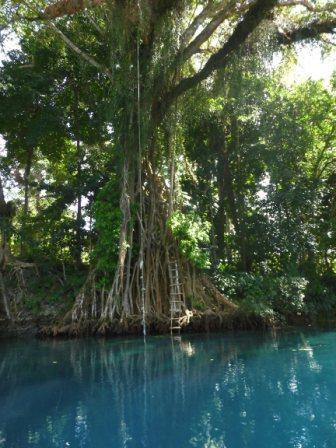Crustacean news

VulcanSpirit
Richard & Alison Brunstrom
Thu 12 Sep 2013 01:42
|
This week's big story is that I have beheld the
world's one and only species of freshwater hermit crab, Clibanarius
fonticulata, by complete surprise. I had no idea such an animal existed
until three days ago - and nor did anyone else until 1990 when it was
discovered by a visiting lady zoologist. Big news if you like crabs as much
as I do; if not it's probably a tad less exciting.
Sadly I can't show you a photograph because
operator error has resulted in us flooding our underwater camera and stangely it
seems that no-one has loaded a picture of it onto the internet. But that
doesn't matter much, because it looks exactly like every other small hermit crab
you've ever seen - a shell with a few antennae and legs peeking out. But I
can show you a picture of the shell it uses - the very strange horned nerite
Cithon corona.
This is a widespread mollusc of brackish water
throughout the Indo-Pacific (it seems that it is unable to breed in freshwater
for reasons that I don't know) with as you can see a set of sharp spines on the
shell (I think perhaps unique amongst non-marine snails). I have no idea of
their purpose, but interesting in their own right. As a complete aside
Cithon has the distinction of being originally described (the scientific
term for the process of formally identifying a species of animal or plant) by
Linneus, the Swedish naturalist who invented the binomial nomenclature system
nowadays used universally by biologists. It is quite amazing how many
species Linneus managed to describe, especially ones like Clithon
which lives in a part of the world barely even known about in Europe when
Linneus was active in the eighteenth century.
Anyway, these banded nerites are living very
happily in a huge freshwater spring called a Blue Hole (the water is a very
striking clear blue), and their discarded shells are being used by the hermit
crab. There are loads of marine hermit crabs, lots of fully terrestrial air
breathing land hermits (all of which need to deposit their larvae in salt
water) and a large number of brackish water species, and lots of freshwater
crabs, shrimps, and lobsters around the world - but no freshwater
hermits other than C.fonticulata. There must be some physiological reason
for this, but I have no idea what it could be.
These hermits must have evolved in situ, in this
one site. Why is a complete mystery. The Blue Hole is a limestone spring (the
whole of eastern Santo island is a huge raised reef), connected to the sea by
its outflow which is big enough to dinghy up. Here we are doing so, through
beautiful coastal forest.
 The crabs are truly freshwater denizens, not
occuring in the tidal parts of the system. Their entire world distribution is a
band 2m deep around the edge of this pool which is about 30m in
diameter. Here is the pool:
 As you can see the water is lovely and clear, with
a narrow band of alga in the shallows this is where the crabs live.
Below you can see a nice banyan tree on the far
side of the pool with rickety steps up to a rope swing. The other half of the
crew of Vulcan Spirit decided to give this a go, resulting in whiplash injuries
to her neck which she has amazingly ascribed to advancing old age - the very
first time in my experience that this possibility has been entertained. I'm sure
she's right.
 |